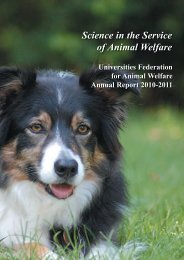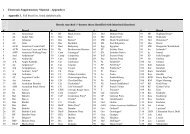Further evidence for the post-release survival of hand-reared ...
Further evidence for the post-release survival of hand-reared ...
Further evidence for the post-release survival of hand-reared ...
You also want an ePaper? Increase the reach of your titles
YUMPU automatically turns print PDFs into web optimized ePapers that Google loves.
30 Kelly et al<br />
Table 3 Post-<strong>release</strong> <strong>survival</strong> <strong>of</strong> six ringed bats <strong>release</strong>d at Stapeley Grange in 2007.<br />
Species Sex Ring number Release weight (g) Release date Date last observed Number <strong>of</strong> days<br />
Common F Z3283 5.2 01/09/2007 24/10/2007 53<br />
Common M Z3254 4.2 05/09/2007 28/10/2007 53<br />
Common M Z2943 † 4.5 11/09/2007 08/10/2007 27<br />
Soprano F Z3279 4.5 31/08/2007 08/10/2007 38<br />
Soprano F Z3280 4.8 31/08/2007 23/04/2008 236<br />
Soprano F Z3278 5.2 31/08/2007 20/06/2011 1,389<br />
† Retrieved day 27 after becoming trapped in building.<br />
Kelly et al (2008). The characteristics <strong>of</strong> <strong>the</strong> radio-tracked<br />
bats are shown in Table 1. The bats were allowed to self<strong>release</strong><br />
from <strong>the</strong>ir original bat boxes which were moved to<br />
<strong>the</strong> outside <strong>of</strong> <strong>the</strong> bat flight. All <strong>of</strong> <strong>the</strong> radio-tracked bats<br />
were active on <strong>the</strong> night <strong>the</strong>y were allowed to self-<strong>release</strong>.<br />
Bats were tracked continuously until <strong>the</strong> bat was retrieved<br />
or <strong>the</strong> signal lost. The bats were tracked again during <strong>the</strong><br />
day to confirm <strong>the</strong> location <strong>of</strong> roosts. For those bats <strong>for</strong><br />
which <strong>the</strong> signal was lost, attempts were made to relocate<br />
<strong>the</strong>m on each consecutive night, until 48 h after <strong>the</strong><br />
estimated battery life <strong>of</strong> <strong>the</strong> transmitter (maximum 14 days).<br />
Ringing<br />
Between 2006 and 2007, thirty-nine fully grown juvenile<br />
bats (all <strong>of</strong> which were admitted as non-independent<br />
juveniles) were fitted with individual numbered 2.9-mm<br />
(internal width when fitted) aluminium ‘open C’ bat rings<br />
(Figure 1). Bat boxes fixed externally to <strong>the</strong> bat flight were<br />
checked on a daily basis by a licensed bat worker and any<br />
ringed bats roosting in <strong>the</strong> boxes were recorded.<br />
Results<br />
Radio-tracking<br />
The ten bats were radio-tracked <strong>for</strong> between one and ten days<br />
(median = 5), (see Table 2). Three bats (Z2945, Z3255 and<br />
Z3259) were retrieved after one, two and four nights, respectively.<br />
Z3283 (female common pipistrelle) and Z3278<br />
(female soprano pipistrelle) were both tracked <strong>for</strong> ten days<br />
following <strong>release</strong> until <strong>the</strong> signal was lost. Both were<br />
observed alive in a bat box at <strong>the</strong> <strong>release</strong> site, 53 and<br />
1,389 days <strong>post</strong>-<strong>release</strong>, respectively. Z3255 was tracked <strong>for</strong><br />
two nights following <strong>release</strong>. On day three, <strong>the</strong> signal was<br />
stationary and <strong>the</strong> bat was subsequently retrieved from a ro<strong>of</strong><br />
space five days after <strong>release</strong>. On retrieval, <strong>the</strong> bat weighed<br />
3.7 g, having lost 0.6 g since <strong>release</strong> (14% <strong>of</strong> its bodyweight).<br />
The antenna <strong>of</strong> <strong>the</strong> transmitter was found to be contaminated<br />
with cobwebs and dirt weighing 0.7 g (Figure 2). Z2945 was<br />
tracked <strong>for</strong> one night be<strong>for</strong>e it became trapped in a chimney<br />
and subsequently retrieved. Z3259 was tracked <strong>for</strong> four<br />
nights be<strong>for</strong>e becoming trapped in a house about 2 km from<br />
<strong>the</strong> <strong>release</strong> site. All three retrieved bats were over-wintered<br />
and subsequently re-<strong>release</strong>d in April 2008.<br />
Ring returns<br />
Five ringed bats (13%) were observed alive in bat boxes on<br />
<strong>the</strong> outside <strong>of</strong> <strong>the</strong> bat flight cage 38 to 1,389 days following<br />
<strong>release</strong> (see Table 3). Three <strong>of</strong> <strong>the</strong>se bats (Z3278, Z3279 and<br />
Z3280) were originally from <strong>the</strong> same roost. A sixth ringed<br />
bat was retrieved 27 days following <strong>release</strong> after becoming<br />
trapped in a building close to <strong>the</strong> <strong>release</strong> site.<br />
Discussion<br />
Although we had to retrieve three <strong>of</strong> <strong>the</strong> radio-tracked bats,<br />
<strong>the</strong> o<strong>the</strong>r seven were successfully radio-tracked <strong>for</strong> between<br />
four and ten days. Combined with <strong>the</strong> data in our previous<br />
report (Kelly et al 2008), 80% survived <strong>for</strong> at least four days.<br />
Taking a more conservative view to account <strong>for</strong> <strong>the</strong> fact that<br />
bats may survive <strong>for</strong> four days without feeding, 60% survived<br />
<strong>for</strong> at least six days, at which stage <strong>the</strong>y must be feeding independently<br />
as <strong>the</strong>y were active on consecutive nights.<br />
However, although radio-tracking is a good indicator <strong>of</strong><br />
short-term <strong>survival</strong>, <strong>the</strong> battery life <strong>of</strong> <strong>the</strong> transmitters<br />
(10–14 days) is limited by <strong>the</strong> size <strong>of</strong> <strong>the</strong> transmitters and is<br />
insufficient <strong>for</strong> us to measure longer-term <strong>survival</strong>. The<br />
observation <strong>of</strong> six ringed bats 27–1,389 days after <strong>release</strong> is<br />
fur<strong>the</strong>r <strong>evidence</strong> that <strong>the</strong>se bats have been able to survive<br />
independently. Z3278 and Z3280, observed 1,389 and<br />
236 days after <strong>release</strong>, respectively, had survived and hibernated<br />
successfully, albeit <strong>the</strong> <strong>for</strong>mer in an unusually mild<br />
winter. Z3278 has now survived three winters including <strong>the</strong><br />
harsh winter <strong>of</strong> 2010–2011 and on <strong>the</strong> last sighting was<br />
observed to be lactating so may have entered <strong>the</strong> breeding<br />
population. Interestingly, three <strong>of</strong> <strong>the</strong> observed ringed bats<br />
(all soprano pipistrelles) observed toge<strong>the</strong>r in <strong>the</strong> bat box<br />
were originally from <strong>the</strong> same roost.<br />
Our study has also highlighted a potential barrier to<br />
successful <strong>release</strong>: <strong>the</strong> apparent inability <strong>of</strong> some bats to<br />
find <strong>the</strong>ir way out <strong>of</strong> buildings and l<strong>of</strong>t spaces. Three <strong>of</strong> <strong>the</strong><br />
ten radio-tracked bats became trapped, and ano<strong>the</strong>r bat<br />
which was ringed but not radio-tracked had to be retrieved<br />
from a rarely used room in a nearby house 27 days after<br />
<strong>release</strong>. However, it is not clear if this is due to <strong>the</strong> bats<br />
being rehabilitated or not. We are not aware <strong>of</strong> any studies<br />
that have examined <strong>the</strong> likelihood <strong>of</strong> non-rehabilitated<br />
juvenile bats becoming trapped or being unable to find an




